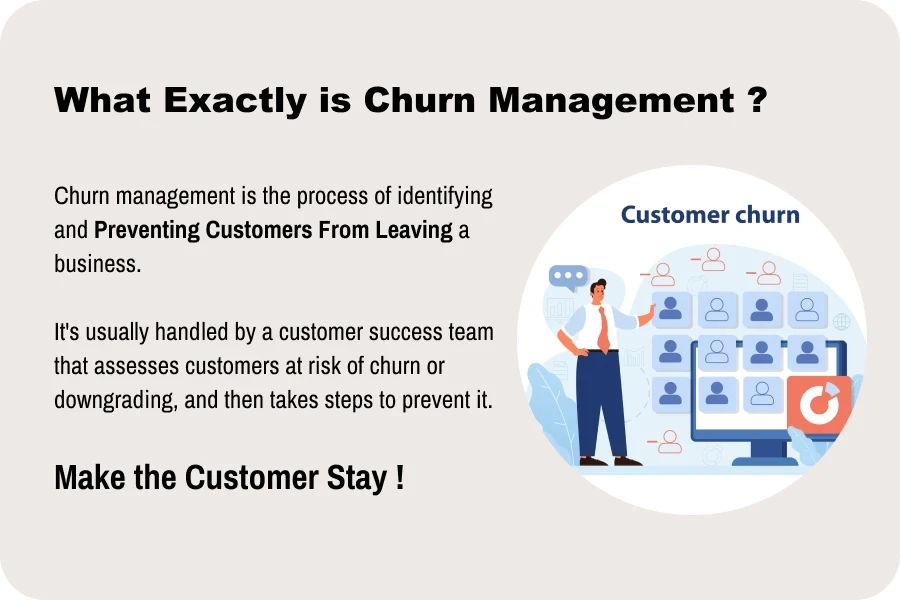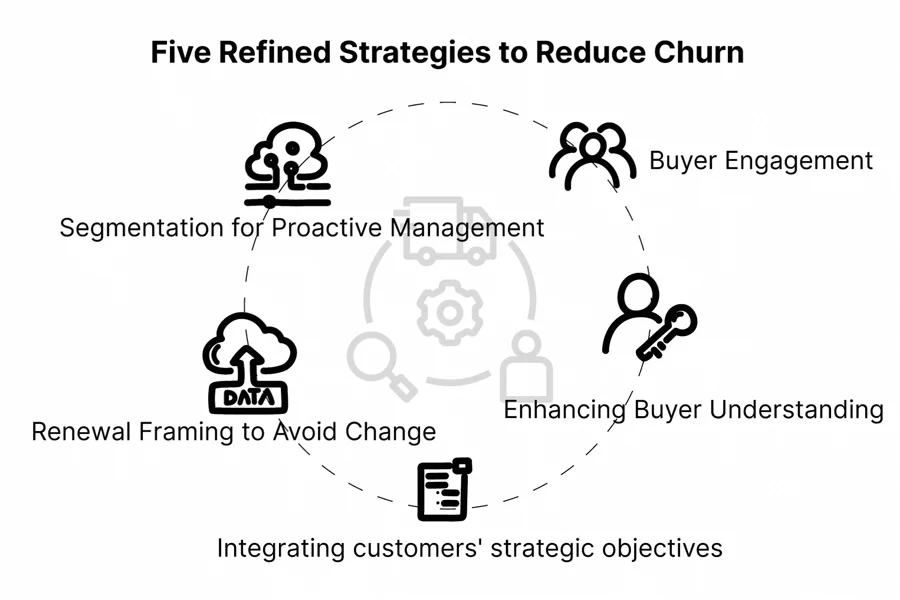Churn Management! Make the Customer Stay in a Business, the art of keeping your customers coming back with these fresh, effective strategies. From chatting up the big decision-makers to tailoring your services to meet customer goals. This blog breaks down how to make customers stick around for the long haul.
Table of Contents
Introduction to Churn Management
Why Churn Management is Crucial
Five Refined Strategies to Reduce Churn
Conclusion: Embracing Effective Churn Management
Introduction to Churn Management
Churn management is an essential practice for any business seeking stability and growth, particularly in unpredictable economic environments. It involves strategically overseeing customer turnover to minimize losses and maximize satisfaction and engagement.

Effective churn management is crucial not just for sustaining revenue but for enhancing overall customer relationships. These efforts ensure that businesses can continue to thrive even in the face of challenges, retaining a solid customer base and securing a competitive advantage in the marketplace.
Why Churn Management is Crucial
The significance of churn management extends beyond mere numbers; it is about sustaining the lifeblood of any business—its customer base. In today’s competitive landscape, losing customers not only impacts immediate revenue but also reduces the lifetime value of relationships that could have fostered future growth.

Effective churn management strategies are critical as they help businesses understand why customers leave and what strategies can be implemented to retain them. This understanding allows for more informed decision-making and strategic planning, which is essential for long-term success. By prioritizing customer retention, companies not only enhance their operational stability but also build a reputation for reliability and customer-centricity in their market.
Five Refined Strategies to Reduce Churn
This part is going ahead to discuss the 5 Strategies businesses can help with Churn Management.

Redefining Buyer Engagement -The Connection with Potential Customers
Traditional retention approaches need an update. Instead of passive renewals, engage directly with economic buyers—those with budget authority. Establish a robust rapport and demonstrate clear ROI to these decision-makers to ensure they see the value in continuing the partnership.

Example: A SaaS company could implement a strategy where account managers set up regular check-ins with CFOs of client companies to discuss usage statistics, the impact on their ROI, and adjustments for upcoming contract renewals. This ensures that economic buyers are continuously aware of the value the service provides, making the renewal decision straightforward.
Enhancing Buyer Understanding -Getting the Lowdown on Our Buyers:
Deepen your understanding of each buyer’s role and strategic interests by employing tailored communication during interactions such as quarterly business reviews (QBRs). This personalized approach not only reinforces the value of your solutions but also aligns your offerings with their current and future needs.

Example: A telecom service provider could use insights from customer data analytics to tailor communication in quarterly business reviews. By highlighting how specific services have improved connectivity and reduced downtime for a client, they can align discussions directly with the needs of the buyer, such as a CTO or IT Director, who prioritizes system reliability.
Strategic Alignment of Solutions -Syncing Our Stuff with Their Big Goals
Position your solutions in a way that they become tightly integrated with your customers’ strategic objectives. This alignment makes your services indispensable, thereby reducing the likelihood of churn due to a misalignment of business goals and services provided.

Example: A healthcare consulting firm might align its services by integrating healthcare compliance updates into its offerings for hospital management. This keeps the service aligned with the strategic goals of the hospital, such as maintaining accreditation standards and improving patient care, making the service indispensable.
Renewal Framing to Avoid Change -Making Renewals a No-Brainer
In renewals, the aim is to maintain the status quo whenever beneficial. Highlight how your solutions continue to be relevant and critical, using the principle of loss aversion to your advantage. Make the cost of switching and the risks of disruption clear, thereby reinforcing the benefits of renewal.

Example: A software vendor could emphasize to an existing customer how their upcoming product updates will include enhanced security features that are crucial in the current cyber-threat landscape. By highlighting the risks and hassles associated with changing providers and retraining staff, they make their continued service the path of least resistance.
Segmentation for Proactive Management -Smart Sorting for Better Vibes:
Analyze your customer base to identify which segments are at risk and which have potential for growth. Tailor your retention efforts based on this segmentation to more effectively address potential churn before it happens. This proactive approach allows for more focused and effective management of customer relationships.

Example: An online retail platform could segment their customers based on purchasing behavior and feedback. For those identified as at risk due to decreased activity, personalized email campaigns offering special discounts or exclusive previews of new products could be used to re-engage them. Conversely, for highly engaged users, they might offer loyalty rewards or beta testing opportunities for upcoming features to enhance retention.
Conclusion: Embracing Effective Churn Management
Successfully managing customer churn is essential for any business aiming to secure its market position and drive growth. The strategies outlined above provide a roadmap for companies to not only understand the dynamics of customer turnover but also to effectively engage and retain their customer base. By redefining how we engage economic buyers, enhancing our understanding of customers’ needs, strategically aligning solutions, framing renewals to avoid change, and proactively managing customer segments, businesses can significantly reduce churn. Each strategy offers a specific approach that, when combined, forms a comprehensive churn management plan tailored to maintaining and expanding a loyal customer base in any economic environment. Implementing these strategies with clear examples as guidance can transform a company’s approach to customer retention, ensuring long-term success and stability.



